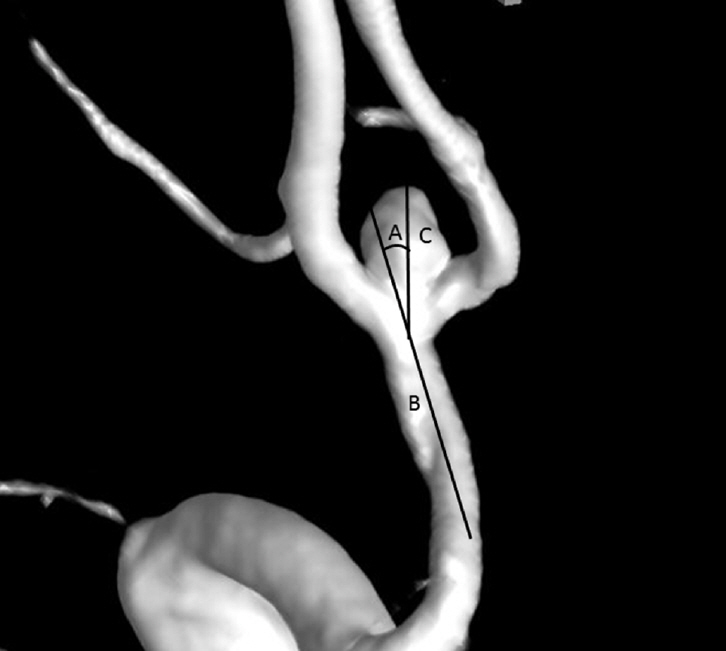J Cerebrovasc Endovasc Neurosurg.
2021 Mar;23(1):1-5. 10.7461/jcen.2020.E2020.07.001.
Characteristics of patients with ruptured very small intracranial aneurysm sized less than 3 mm
- Affiliations
-
- 1Department of Neurosurgery, Yeungnam University Medical Center, Daegu, Korea
- KMID: 2514332
- DOI: http://doi.org/10.7461/jcen.2020.E2020.07.001
Abstract
Objective
If the size of an intracranial aneurysm is below 3 mm, clinicians rarely treat them because of the low risk of rupture. But subarachnoid hemorrhage (SAH) due to the rupture of very small intracranial aneurysm (VSIA) (saccular aneurysm sized less than 3 mm) may lead to many critical neurological complications. So we analyzed the characteristics and differences between the ruptured VSIA group and the ruptured non-VSIA group.
Methods
421 saccular aneurysms from patients with SAH between January 2016 and December 2019 were included. Patient information including age, sex, and medical history and information about the aneurysm including location, size, aspect ratio, inflow angle, and height-width ratio were collected. And we compared the VSIA group with non-VSIA group about these characteristics
Results
12.1% (51/421) of the aneurysms were included in the VSIA group, while the non-VSIA group consisted of 87.9% of the aneurysms (370/421). The female predominance was significantly higher in the VSIA group than that in the non-VSIA group (p=0.011). No significant difference was observed in location, medical history, height-width ratio between the groups. The mean value of the inflow angle in the VSIA group was much lower than that in the non-VSIA group, but no statistically significant association between rupture risk and the inflow angle was observed. The average aspect ratio was significantly lower than that in the non-VSIA group.
Conclusions
Ruptured VSIA group has higher percentage of females and lower aspect ratio than ruptured non-VSIA group. Further studies regarding the characteristics of ruptured and unruptured VSIA patients is required for assistance in clinical decision related to treatment of VSIA group before the aneurysmal sac rupture.
Figure
Reference
-
1. Brown RD. Unruptured intracranial aneurysms. Semin Neurol. 2010; Nov. 30(5):537–44.
Article2. Brown RD Jr, Broderick JP. Unruptured intracranial aneurysms: epidemiology, natural history, management options, and familial screening. Lancet Neurol. 2014; Apr. 13(4):393–404.
Article3. Duan Z, Li Y, Guan S, Ma C, Han Y, Ren X, et al. Morphological parameters and anatomical locations associated with rupture status of small intracranial aneurysms. Sci Rep. 2018; Apr. 8(1):6440.
Article4. Ikawa F, Morita A, Tominari S, Nakayama T, Shiokawa Y, Date I, et al. Rupture risk of small unruptured cerebral aneurysms. J Neurosurg. 2019; Jan. 1–10.
Article5. Jamroz T, Jakutowicz I, Hofman M, Kolodkiewicz M, Cmiel M, Lapaj A, et al. Safety and efficacy of treatment of very small intracranial aneurysms. Pol J Radiol. 2019; Sep. 84:e360–4.6. Lee GJ, Eom KS, Lee C, Kim DW, Kang SD. Rupture of very small intracranial aneurysms: incidence and clinical characteristics. J Cerebrovasc Endovasc Neurosurg. 2015; Sep. 17(3):217–22.
Article7. Malhotra A, Wu X, Forman HP, Grossetta Nardini HK, Matouk CC, Gandhi D, et al. Growth and Rupture Risk of Small Unruptured Intracranial Aneurysms: A Systematic Review. Ann Intern Med. 2017; Jul. 167(1):26–33.8. UCAS Japan Investigators, Morita A, Kirino T, Hashi K, Aoki N, Fukuhara S, Hashimoto N, et al. The natural course of unruptured cerebral aneurysms in a Japanese cohort. N Engl J Med. 2012; Jun. 366(26):2474–82.
Article9. Nader-Sepahi A, Casimiro M, Sen J, Kitchen ND. Is aspect ratio a reliable predictor of intracranial aneurysm rupture? Neurosurgery. 2004; Jun. 54(6):1343–7. discussion 1347-8.
Article10. Suarez JI. Diagnosis and Management of Subarachnoid Hemorrhage. Continuum (Minneap Minn). 2015; Oct. 21(5 Neurocritical Care):1263–87.
Article11. Tai J, Liu J, Lv J, Huibin K, Hou Z, Yang J, et al. Risk factors predicting a higher grade of subarachnoid haemorrhage in small ruptured intracranial aneurysm (< 5 mm). Neurol Neurochir Pol. 2019; 53(4):296–303.12. Turan N, Heider RA, Zaharieva D, Ahmad FU, Barrow DL, Pradilla G. Sex differences in the formation of intracranial aneurysms and incidence and outcome of subarachnoid hemorrhage: review of experimental and human studies. Transl Stroke Res. 2016; Feb. 7(1):12–9.
Article
- Full Text Links
- Actions
-
Cited
- CITED
-
- Close
- Share
- Similar articles
-
- Rupture of Very Small Intracranial Aneurysms: Incidence and Clinical Characteristics
- What Is the Significance of a Large Number of Ruptured Aneurysms Smaller than 7 mm in Diameter?
- The Proportion of Small Aneurysms in the Ruptured Cerebral Aneurysmal Cases : Is the Small Aneurysm Safe From Rupture?
- Prediction of Aneurysm Rupture and Amount of Subarachonoid Hemorrhage in Patients with Unruptured Intracranial Aneurysm
- Surgical Intervention for Cases of Ruptured Intracranial Aneurysms Accompanying Large Intracranial Hematomas



